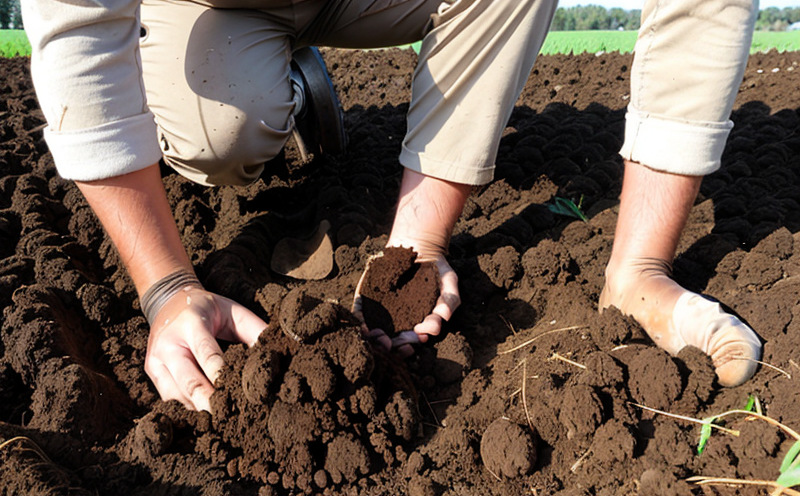Soil Extractable Potash Testing
The testing of soil extractable potash is a critical component in agricultural and forestry management. This service provides insight into the available potassium (K+) ions that can be readily absorbed by plant roots, which is essential for understanding fertility levels and optimizing crop yields. The availability of potash in soil solution directly impacts plant growth and health; thus, this testing plays a pivotal role in precision agriculture.
The process involves extracting potassium from the soil using an aqueous solution under controlled conditions. This extraction allows for the measurement of the amount of available potassium that can be accessed by plants during their active growing periods. Understanding these levels helps stakeholders make informed decisions about fertilization practices, nutrient management strategies, and overall crop health.
In precision agriculture, this service is particularly useful for identifying areas within a field where soil fertility may vary. By pinpointing zones with lower available potash concentrations, farmers can apply targeted amendments or adjust their irrigation schedules to maximize resource use efficiency. This approach not only enhances productivity but also contributes to more sustainable farming practices by reducing unnecessary inputs.
The methodology employed in this testing aligns closely with international standards such as ISO 17245:2013, which provides guidelines for soil extractant solutions and extraction procedures. Compliance with these standards ensures reliability and consistency across different laboratories, enhancing comparability of results between various studies or geographical locations.
For research purposes, this testing serves as a crucial tool in evaluating the effectiveness of new fertilizers or amendments on soil health over time. It allows researchers to monitor changes in extractable potassium levels before and after application, providing valuable data for developing more effective nutrient management plans.
Scope and Methodology
| Step | Procedure | Instrumentation |
|---|---|---|
| Sample Collection | Select representative soil samples from various depths and locations within the field. Ensure that each sample is homogenized before analysis. | N/A |
| Extraction Solution Preparation | Mix distilled water with a known concentration of potassium nitrate to create the extraction solution according to ISO 17245:2013. | Pipettes, beakers |
| Solution Application | Apply the prepared solution uniformly over the collected soil samples. | Graduated cylinders, stirrers |
| Incubation Period | - | |
| Filtering and Collection | Filter the extracted solution through a fine-mesh filter into a clean container. | Funnel, filters |
| Analysis | Determine the concentration of potassium ions using atomic absorption spectrophotometry (AAS). This method accurately quantifies the amount of extractable potash present in the soil solution. | Absorption Spectrometer |
The entire process is meticulously documented, ensuring traceability and reproducibility. The use of standard protocols guarantees that results are reliable and valid for decision-making purposes. Compliance with international standards ensures consistency across different laboratories, making the findings comparable internationally.
Benefits
The benefits of soil extractable potash testing extend beyond mere data collection; they encompass improved agricultural productivity, enhanced environmental sustainability, and better resource management. Firstly, precise knowledge about available potassium levels enables farmers to tailor their fertilization practices more effectively, leading to increased crop yields without overuse of nutrients.
Secondly, this service supports sustainable farming by promoting efficient use of resources like water and chemical inputs. By focusing on areas where soil fertility is low, unnecessary application of potash can be avoided, reducing costs for producers while minimizing potential environmental impacts such as runoff pollution.
Thirdly, the results from these tests are invaluable in long-term research projects aimed at understanding how different management practices affect soil health over time. Such information helps scientists develop more robust models predicting future trends in crop performance under changing climatic conditions or policy frameworks promoting eco-friendly farming methods.
In summary, soil extractable potash testing offers a comprehensive approach to assessing the nutritional status of agricultural lands and forests, supporting both short-term operational decisions and long-term strategic planning efforts. Its application across various sectors underscores its importance in achieving balanced ecosystems where economic growth meets ecological responsibility.
Competitive Advantage and Market Impact
The ability to accurately measure soil extractable potash provides a significant competitive advantage in the marketplace, particularly for companies involved in precision agriculture, research institutions conducting field trials, and environmental consulting firms advising on sustainable land use practices.
Agricultural businesses that leverage this service gain access to highly detailed information about their fields' nutritional profiles. This knowledge allows them to implement targeted fertilization programs, which can lead to higher yields at lower costs compared to broad-spectrum applications. For instance, if certain sections of a farm have low extractable potassium levels but high overall soil quality, applying localized treatments ensures that resources are used more efficiently.
Research organizations benefit from reliable data generated through consistent testing methods aligned with international standards like ISO 17245:2013. This consistency enhances the credibility of their findings and facilitates collaboration among different research groups worldwide. Environmental consultants can use this information to provide tailored advice on soil improvement projects, helping clients comply with regulatory requirements related to sustainable agriculture.
Furthermore, as climate change continues to influence global agricultural landscapes, having accurate baseline data on soil nutrient availability becomes increasingly crucial. Companies that invest in advanced soil testing technologies and methodologies position themselves well for future challenges by staying ahead of evolving standards and best practices.





